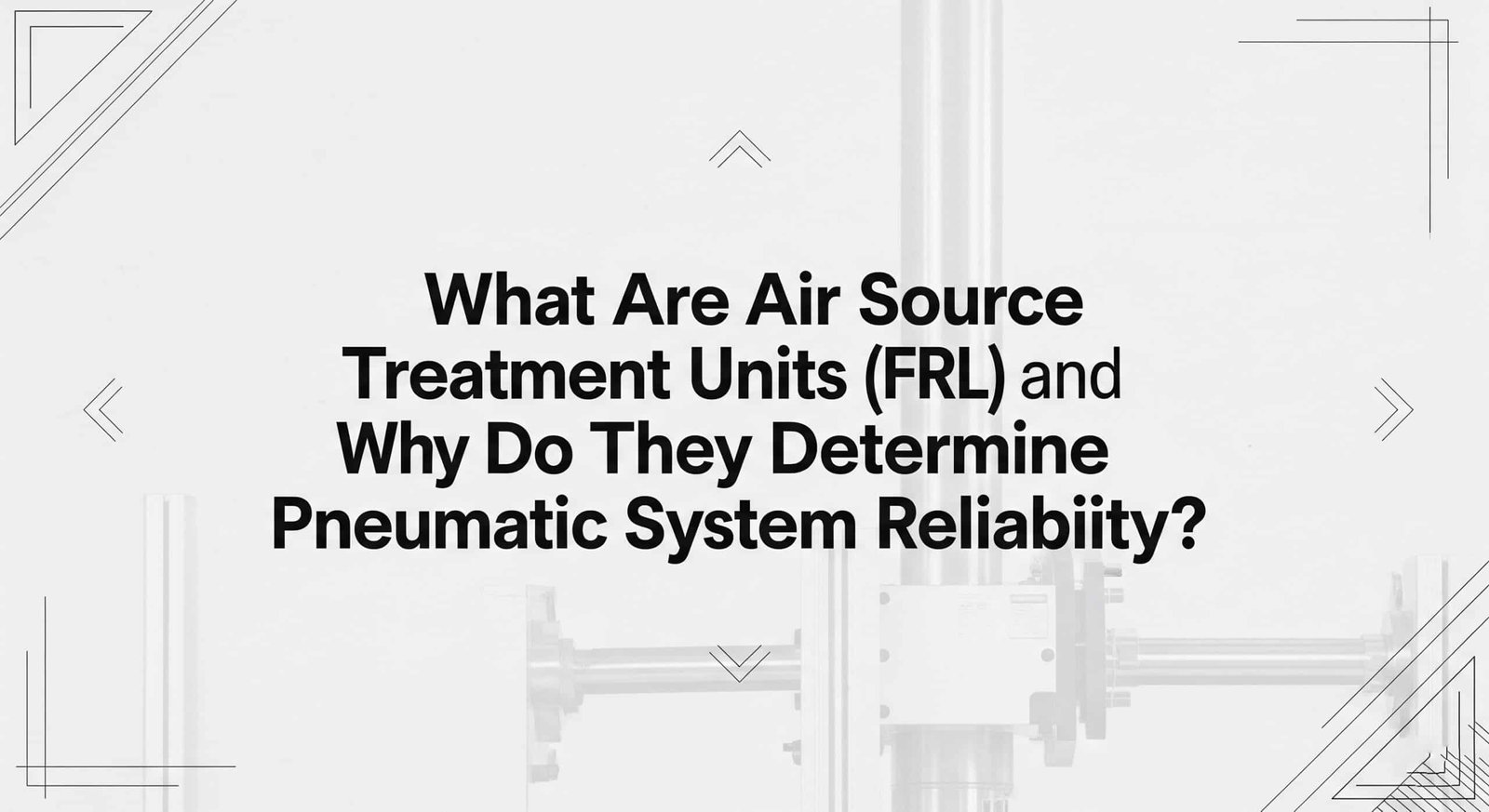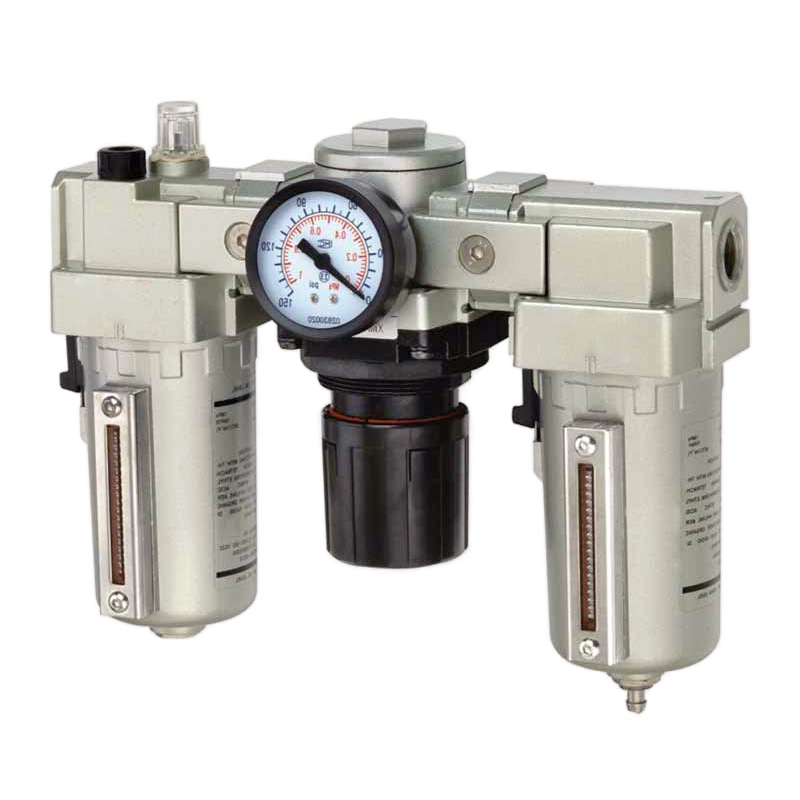When your pneumatic system experiences frequent cylinder seal failures and inconsistent performance that costs $18,000 weekly in downtime and repairs, the root cause often traces back to contaminated, wet, or improperly regulated compressed air that destroys components from the inside out.
Air Source Treatment Units (FRL) are three-component systems combining Filter, Regulator, and Lubricator that clean, control pressure, and condition compressed air before it reaches pneumatic equipment, ensuring optimal performance and extending component life by removing contaminants, stabilizing pressure, and providing proper lubrication.
Last week, I helped Thomas Mueller, a maintenance engineer at a packaging facility in Stuttgart, Germany, whose rodless cylinders were failing every 3 months due to moisture and particle contamination in their air supply system.
Table of Contents
- What Components Make Up FRL Air Treatment Systems?
- How Do FRL Units Protect Pneumatic Equipment from Damage?
- Which FRL Specifications Match Different Industrial Applications?
- Why Do Proper FRL Selection and Maintenance Maximize ROI?
What Components Make Up FRL Air Treatment Systems?
FRL units integrate three essential pneumatic components that work together to deliver clean, regulated, and properly conditioned compressed air.
FRL systems consist of a Filter that removes particles and moisture down to 5 microns, a Pressure Regulator that maintains consistent output pressure within ±2%, and a Lubricator that adds precise oil mist for component protection, with each component serving a critical role in air preparation.
Filter Component Functions
Particle Removal
- Filtration Rating: 5, 25, or 40 micron1 options
- Contaminant Types: Dirt, rust, pipe scale, oil droplets
- Efficiency: 99.9% removal at rated micron size
- Capacity: Handles 50-5000 L/min flow rates
Moisture Separation
- Condensate Removal: Automatic or manual drain systems
- Water Collection: Transparent bowl for visual monitoring
- Coalescing Action: Combines water droplets for drainage
- Temperature Range: -10°C to +60°C operation
Pressure Regulator Technology
Pressure Control Features
- Input Range: Typically 0.5-16 bar maximum
- Output Range: Adjustable 0.5-10 bar typical
- Accuracy: ±2% regulation under varying flow
- Response: Fast reaction to pressure changes
Flow Characteristics
- Cv Values2: 0.5-15 depending on size
- Flow Rates: 50-8000 L/min capacity
- Pressure Drop: Minimal restriction when properly sized
- Stability: Maintains set pressure regardless of demand
Lubricator Operation
Oil Distribution System
- Metering: Precise oil drop control
- Atomization: Creates fine oil mist
- Distribution: Even coating of downstream components
- Adjustment: Variable oil flow rate settings
Lubrication Benefits
- Seal Protection: Prevents premature wear
- Corrosion Prevention: Protects internal surfaces
- Performance: Reduces friction and sticking
- Life Extension: Doubles typical component lifespan
FRL Component Comparison
| Component | Primary Function | Key Benefit | Maintenance Interval |
|---|---|---|---|
| Filter | Contaminant removal | Clean air supply | 3-6 months |
| Regulator | Pressure control | Consistent performance | 12 months |
| Lubricator | Air conditioning | Component protection | 6-12 months |
How Do FRL Units Protect Pneumatic Equipment from Damage?
FRL systems provide comprehensive air treatment that prevents the most common causes of pneumatic component failure and performance degradation.
FRL units protect pneumatic equipment by removing harmful contaminants that cause seal wear, maintaining stable pressure that prevents component stress, and providing lubrication that reduces friction and corrosion, typically extending equipment life by 200-300% while reducing maintenance costs by 60-80%.
Contamination Protection
Particle Damage Prevention
- Seal Scoring: Prevents abrasive particles from damaging seals
- Valve Sticking: Eliminates debris that causes valve malfunctions
- Surface Wear: Protects precision surfaces from scratching
- Blockage Prevention: Keeps small orifices clear
Moisture Control Benefits
- Corrosion Prevention: Eliminates rust and oxidation
- Freeze Protection: Prevents ice formation in cold environments
- Bacterial Growth: Reduces contamination in air lines
- Electrical Issues: Prevents moisture-related control problems
Pressure Regulation Advantages
Component Protection
- Overpressure Prevention: Protects against pressure spikes
- Consistent Force: Maintains uniform actuator performance
- Energy Efficiency: Optimizes air consumption
- System Stability: Reduces pressure fluctuations
Performance Optimization
- Speed Control: Consistent pressure enables precise timing
- Force Repeatability: Uniform pressure ensures consistent output
- Cycle Consistency: Eliminates performance variations
- Quality Improvement: Stable operation improves product quality
Real-World Protection Story
Two months ago, I worked with Sarah Johnson, operations manager at an automotive parts facility in Detroit, Michigan. Her assembly line was experiencing cylinder seal failures every 6 weeks, costing $12,000 monthly in replacement parts and downtime. The compressed air system had no filtration, and moisture was causing severe corrosion. We installed Bepto FRL units throughout the system, immediately extending seal life to over 18 months and reducing maintenance costs by 75%. The investment paid for itself in just 4 months through reduced downtime and parts costs. 💰
Damage Prevention Matrix
| Without FRL | Typical Problems | With FRL | Protection Results |
|---|---|---|---|
| Dirty Air | Seal wear, valve sticking | Clean Air | 300% longer seal life |
| Variable Pressure | Inconsistent performance | Stable Pressure | ±2% pressure accuracy |
| Dry Air | Premature wear, corrosion | Lubricated Air | 200% component lifespan |
| Wet Air | Rust, freeze-up | Dry Air | Eliminates moisture damage |
Which FRL Specifications Match Different Industrial Applications?
Different industrial applications require specific FRL configurations and specifications to optimize performance and cost-effectiveness.
FRL specifications vary by application, with light-duty systems using 40-micron filtration and 6-bar regulation, medium-duty applications requiring 25-micron filters and 10-bar capacity, and heavy industrial systems needing 5-micron filtration, 16-bar regulation, and automatic drainage for maximum contamination control.

Application-Based FRL Selection
Light Industrial Applications
- Industries: Packaging, food processing, textiles
- Filter Rating: 40 micron standard filtration
- Pressure Range: 0-6 bar regulation
- Flow Capacity: 50-500 L/min
- Features: Manual drain, basic pressure gauge
Medium Industrial Applications
- Industries: Automotive, electronics, general manufacturing
- Filter Rating: 25 micron high-efficiency filtration
- Pressure Range: 0-10 bar with precision control
- Flow Capacity: 500-2000 L/min
- Features: Semi-automatic drain, digital pressure display
Heavy Industrial Applications
- Industries: Steel, mining, petrochemical, heavy machinery
- Filter Rating: 5 micron ultra-fine filtration
- Pressure Range: 0-16 bar high-pressure capability
- Flow Capacity: 2000-8000 L/min
- Features: Automatic drain, redundant filtration, explosion-proof3 options
FRL Sizing Guidelines
Flow Rate Calculation
Required Cv = Actual Flow Rate ÷ (Pressure Drop Factor × Efficiency Factor)
Pressure Drop Considerations
- Filter: 0.1-0.3 bar typical pressure drop
- Regulator: 0.2-0.5 bar regulation differential
- Lubricator: 0.1-0.2 bar minimal restriction
- Total System: Plan for 0.5-1.0 bar total drop
Industry-Specific Requirements
| Industry | Filter Rating | Pressure Range | Special Features | Typical Savings |
|---|---|---|---|---|
| Food Processing | 5 micron | 0-6 bar | Stainless steel, FDA approved | 40% maintenance reduction |
| Automotive | 25 micron | 0-10 bar | High flow, compact design | 50% downtime reduction |
| Electronics | 5 micron | 0-8 bar | Oil-free options, precise control | 60% defect reduction |
| Heavy Manufacturing | 5 micron | 0-16 bar | Automatic drain, high capacity | 70% component life extension |
Why Do Proper FRL Selection and Maintenance Maximize ROI?
Strategic FRL system selection and maintenance programs deliver substantial returns through reduced downtime, extended equipment life, and improved operational efficiency.
Proper FRL selection and maintenance maximize ROI by reducing pneumatic component failures by 80%, extending equipment life by 200-300%, and decreasing energy consumption by 15-25%, with typical Payback Period4 of 6-12 months and annual savings of $50,000-200,000 for medium-sized facilities.
ROI Calculation Framework
Cost Reduction Areas
- Component Replacement: 60-80% reduction in seal and valve costs
- Maintenance Labor: 50% fewer service calls and repairs
- Downtime Prevention: 90% reduction in air system failures
- Energy Savings: 15-25% lower compressor operating costs
Investment Payback Analysis
- Initial Cost: FRL units typically $200-2000 per installation
- Annual Savings: $5,000-50,000 per production line
- Payback Period: 6-18 months depending on application
- Long-term ROI: 300-500% over 5-year equipment life
Bepto FRL Advantages
Quality and Performance
- Extended Service Life: 50% longer than standard units
- Superior Filtration: 99.99% efficiency at rated micron size
- Precise Regulation: ±1% pressure accuracy
- Reliable Operation: 24/7 continuous duty rating
Cost-Effectiveness
- Competitive Pricing: 30-40% savings vs. premium brands
- Fast Delivery: 24-48 hours for standard configurations
- Technical Support: Free sizing and selection assistance
- Warranty Coverage: 2-year comprehensive warranty
Maintenance Program Benefits
Preventive Maintenance Schedule
- Monthly: Visual inspection, drain condensate
- Quarterly: Replace filter elements, check settings
- Semi-Annual: Service regulators, refill lubricators
- Annual: Complete system overhaul and calibration
Maintenance Cost Comparison
- Reactive Maintenance: $15,000-30,000 annual costs
- Preventive Program: $3,000-8,000 annual investment
- Net Savings: $12,000-22,000 yearly benefit
- Reliability Improvement: 95%+ uptime achievement
Our customers consistently achieve 250-400% ROI through proper FRL implementation and maintenance, making it one of the most cost-effective investments in pneumatic system reliability. 📈
Conclusion
Air Source Treatment Units (FRL) are essential components that protect pneumatic systems by cleaning, regulating, and conditioning compressed air, delivering substantial ROI through extended equipment life and reduced maintenance costs.
FAQs About Air Source Treatment Units FRL
What is the difference between FRL units and individual air treatment components?
FRL units combine Filter, Regulator, and Lubricator in an integrated system that provides complete air treatment, while individual components require separate installation and may not work as efficiently together. Integrated FRL systems offer better performance matching, simplified maintenance, and typically 20-30% cost savings compared to purchasing separate components, plus they ensure optimal air quality through coordinated operation.
How often should FRL components be serviced and what are the maintenance requirements?
FRL maintenance intervals vary by component: filters need element replacement every 3-6 months, regulators require annual service, and lubricators need oil refills every 6-12 months, with total annual maintenance costs typically under $500 per unit. Our Bepto FRL systems include maintenance indicators that show when service is needed, and we provide complete maintenance kits with detailed instructions to minimize downtime and ensure optimal performance.
What micron rating should I choose for my pneumatic system filtration needs?
Filter micron rating selection depends on application requirements: 40 micron for general industrial use, 25 micron for precision applications, and 5 micron for critical systems like electronics or medical equipment. Finer filtration provides better protection but increases pressure drop and maintenance frequency, so we recommend 25 micron as the optimal balance for most industrial pneumatic systems.
Can FRL units work with oil-free compressed air systems and what are the alternatives?
Standard FRL units can work with oil-free systems by omitting the lubricator component, creating an FR (Filter-Regulator) combination, while specialized oil-free lubricators use synthetic alternatives for systems requiring lubrication without petroleum products. For completely oil-free applications, we recommend high-quality seals and components designed for dry operation, plus regular maintenance to prevent premature wear.
How do I properly size an FRL unit for my pneumatic system flow requirements?
FRL sizing requires calculating total system flow demand and selecting units with Cv ratings 25-50% higher than calculated requirements to account for pressure drop and future expansion, with typical sizing ranging from 50 L/min for small systems to 8000 L/min for large industrial applications. We provide free sizing consultation and calculation tools to ensure optimal FRL selection that balances performance, efficiency, and cost-effectiveness for your specific application.
-
See a visual comparison to understand the microscopic scale of a micron and its importance in filtration. ↩
-
Access a technical guide and calculator for determining the Flow Coefficient (Cv) value for system components. ↩
-
Review the definition and standards for explosion-proof equipment as defined by safety authorities like OSHA. ↩
-
Use a calculator to determine the Payback Period for investments in energy-saving industrial equipment. ↩





